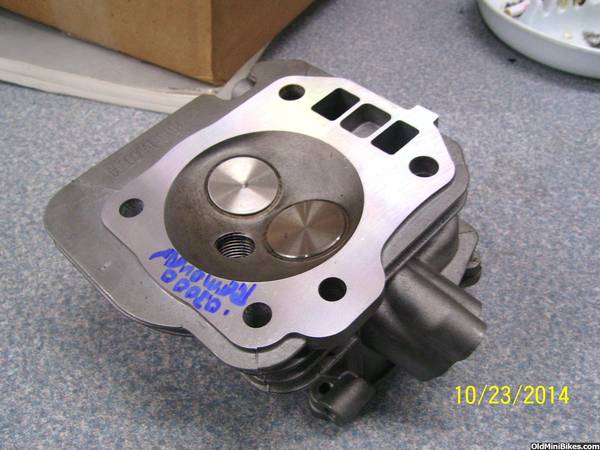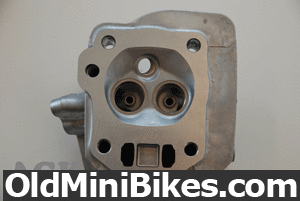What Head To Run
- Thread starter Bonanza Bryan
- Start date
- Tags head run
I like the hemi head for the bigger valves and the 5.5mm stems... I used one on my last build had it milled .030 and it runs just fine.
Here's a pic...notice how the valves are not straight but at a angle.
 [[/SIZE]
[[/SIZE]
HEMI HEAD
Here's a pic...notice how the valves are not straight but at a angle.
HEMI HEAD
Last edited:
This is a fairly good flowing stock head that we use on the more stock racing kart engines.
Box Stock Honda Clone Cylinder Head,TG-1 High Flow, Go Kart Racing, 6.5HP
Box Stock Honda Clone Cylinder Head,TG-1 High Flow, Go Kart Racing, 6.5HP
The G200 hemi head is working with a lot of tinkering.
But its not the head I thought it would become.
More work needs to be done.
My welded hemi project remains in limbo for now.
To be completely frank, a complete rethink on that head is needed.
Its the ports not matching the valve angle, its the bad as cast shape.
There is a lot of planning to go into making this work right.
But its not the head I thought it would become.
More work needs to be done.
My welded hemi project remains in limbo for now.
To be completely frank, a complete rethink on that head is needed.
Its the ports not matching the valve angle, its the bad as cast shape.
There is a lot of planning to go into making this work right.
Look Bryan the stock head you have already has BIG VALVES a 27 mm intake and a 25 ex . The 14 which OldMiniBikes has will give you more compression but that's it . It will not flow as well it has SMALLER VALVES and not the best ports . Your stock head may have smaller valve stems but that just helps flow . I run your same head with a black mamba and 1.3 billet rockers and the stock valve setup . The only parts changed in the head were I used Honda rocker studs . As for milling I took off 78 thousand which is a lot , ended up with about 13.6 compression . How I mill is I sand the head , I have a marble tile from Home Depot with 80 grit square sticky sanding pads stuck on it and I rud the head back and forth while changing directions to mill my heads . It slow when your doing almost 80 thou . But you could do like 35-40 to start with and be good for pump gas . If you have any questions just PM me .
78 thousands with a piece of floor tile and some sandpaper? Yikes! I thought you had access to some machinery? I can't say that too many folks here, if anyone here for that matter, would recommend this!
Bryan, if you need the head milled, find a local machine shop! Nearly impossible to to get a square cut off the floor!
Bryan, if you need the head milled, find a local machine shop! Nearly impossible to to get a square cut off the floor!
hey bryan,
here is some info coming right from NR-racing
i think this will tell you alot in what direction you need to go with milling and porting and your rocker arm ratio. i personally are using 1.3 rockers on a stock lift harden cam with just more duration and it works great. you can see what NR is also saying about what kind of problems you can have when you start to get into high lift cams and 1.2 and 1.3 rockets. i know guys here are going to still give there opinions. just like i am and for the most part the guys are right. main thing is you want to build it once and not have to take it all apart again and NR racing have done 100's of testing and knows what works...........:thumbsup:
NR-racing
The only advantage to a 14cc head is that compression can be increased to around 10.3 to 1 by just bolting on ahead. You need to mill a 18cc head .050" to achieve that. However, a .050" 18cc head can make more power than an unmilled 14 cc head.
Here is some info from previous posting I did:
The key to making power with a Honda head is mild porting, smoothing out the short side radius, blending the bowl, and shortening the valve guides by .100". Together these will yield about 60% better flow than stock. Trying to remove any material (i.e. making the port larger) tends to hurt performance and there is really not enough aluminum to do so. In fact raising the floor of the port improves flow quite a bit. Honda ports (esp. the exhaust) are intentionally oversized to promote cooling. The ports should also be left rough since this creates a boundary layer that improves flow. Best is too sand blast the ports after porting/smoothing. This type of surface will flow much better than a polished surface, plus it helps fuel atomization. The exhaust is not so critical since carbon buildup creates a rough surface on its own.
A good three-angle valve job will allow up to 15% improvement in flow on a GX160/200 head. Unless running huge Mikunis or Tilly’s and turning 7000+ rpm, the stock valve sizes work very well and are capable of making up to 16+ hp. Stainless valves do flow a bit better than stock stuff. For high RPM operation (with big carbs & cams) the 27.5 mm intake valve will help and will allow 20 hp. We have tested 28.5 & larger valves but have not seen any improvement. In fact, we have seen power decreases on the dyno using these. The exhaust valve size should be left alone as it is too big to begin with. A few years ago we installed a smaller seat along a 120 intake valve in a GX160 exhaust port. The motor showed improvement, esp. on the low end.
It is important to know that actual flow through the head is also a function of valve lift. Needless to say, the more lift, the more flow. (Note: higher lifts can decrease velocity, which in turn decreases torque). For the most part, GX200s show improvement as lift is increased. However, on the flow bench a GX160 race head (big valve, ported, milled) does not show any additional flow after about .350 lift. Dyno testing combos above .350 lift (i.e. .400 lift) has shown only minimal high RPM improvement usually at great losses at the low end. Also, the Honda valve train does not do well with a lot of lift. There are a lot of geometry issues that one must address. In fact 1.3 rockers should be avoided as they really play havoc on the geometry. We have seen many failures from using 1.3 rockers with big cams. You can get them to work, but custom valves, spring pocket, and other head work is needed. Stock with stock or 1.2 ratios if possible.
The best combinations for max power tend to be big duration cams (~260 at .050) at .330 to .350 lift. Cam with .280 to .290 lift using 1.2 rockers or .308 cams with 1.1 rockers tend to work the best. However for most applications (i.e. all around performance), a .270 to .280 lift 220 to 230 duration cam combined with 1.1 or 1.2 rockers will be the best set-up. Cam timing is also critical…..
NR-Racing.com
here is some info coming right from NR-racing
i think this will tell you alot in what direction you need to go with milling and porting and your rocker arm ratio. i personally are using 1.3 rockers on a stock lift harden cam with just more duration and it works great. you can see what NR is also saying about what kind of problems you can have when you start to get into high lift cams and 1.2 and 1.3 rockets. i know guys here are going to still give there opinions. just like i am and for the most part the guys are right. main thing is you want to build it once and not have to take it all apart again and NR racing have done 100's of testing and knows what works...........:thumbsup:
NR-racing
The only advantage to a 14cc head is that compression can be increased to around 10.3 to 1 by just bolting on ahead. You need to mill a 18cc head .050" to achieve that. However, a .050" 18cc head can make more power than an unmilled 14 cc head.
Here is some info from previous posting I did:
The key to making power with a Honda head is mild porting, smoothing out the short side radius, blending the bowl, and shortening the valve guides by .100". Together these will yield about 60% better flow than stock. Trying to remove any material (i.e. making the port larger) tends to hurt performance and there is really not enough aluminum to do so. In fact raising the floor of the port improves flow quite a bit. Honda ports (esp. the exhaust) are intentionally oversized to promote cooling. The ports should also be left rough since this creates a boundary layer that improves flow. Best is too sand blast the ports after porting/smoothing. This type of surface will flow much better than a polished surface, plus it helps fuel atomization. The exhaust is not so critical since carbon buildup creates a rough surface on its own.
A good three-angle valve job will allow up to 15% improvement in flow on a GX160/200 head. Unless running huge Mikunis or Tilly’s and turning 7000+ rpm, the stock valve sizes work very well and are capable of making up to 16+ hp. Stainless valves do flow a bit better than stock stuff. For high RPM operation (with big carbs & cams) the 27.5 mm intake valve will help and will allow 20 hp. We have tested 28.5 & larger valves but have not seen any improvement. In fact, we have seen power decreases on the dyno using these. The exhaust valve size should be left alone as it is too big to begin with. A few years ago we installed a smaller seat along a 120 intake valve in a GX160 exhaust port. The motor showed improvement, esp. on the low end.
It is important to know that actual flow through the head is also a function of valve lift. Needless to say, the more lift, the more flow. (Note: higher lifts can decrease velocity, which in turn decreases torque). For the most part, GX200s show improvement as lift is increased. However, on the flow bench a GX160 race head (big valve, ported, milled) does not show any additional flow after about .350 lift. Dyno testing combos above .350 lift (i.e. .400 lift) has shown only minimal high RPM improvement usually at great losses at the low end. Also, the Honda valve train does not do well with a lot of lift. There are a lot of geometry issues that one must address. In fact 1.3 rockers should be avoided as they really play havoc on the geometry. We have seen many failures from using 1.3 rockers with big cams. You can get them to work, but custom valves, spring pocket, and other head work is needed. Stock with stock or 1.2 ratios if possible.
The best combinations for max power tend to be big duration cams (~260 at .050) at .330 to .350 lift. Cam with .280 to .290 lift using 1.2 rockers or .308 cams with 1.1 rockers tend to work the best. However for most applications (i.e. all around performance), a .270 to .280 lift 220 to 230 duration cam combined with 1.1 or 1.2 rockers will be the best set-up. Cam timing is also critical…..
NR-Racing.com


